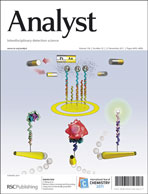A biosensor based on Trametes versicolorlaccase (Lac) was developed for the determination of phenolic compounds. The biosensor was prepared by in situelectrospinning of a mixture of polyvinyl alcohol (PVA), Lac, PEO–PPO–PEO (F108) and gold nanoparticles (Au NPs), where F108 was used as an enzyme stabilizing additive and Au NPs was used to enhance the conductivity of the biosensor. Laser confocal scanning microscopy and electrochemical impedance spectroscopy proved that the enzyme was successfully encapsulated into the electrospun nanofibers. Under the optimal conditions, the lowest detection limit was found to be 0.04 μM (S/N = 3) for 2,4-DCP and the highest detection limit was found to be 12.10 μM for 4-CP. The sensitivity of the biosensor obtained in the linear range for chlorophenols followed the sequence 2,4-dichlorophenol (2,4-DCP) > 2,4,6-trichlorophenol (2,4,6-TCP) > 4-chlorophenol (4-CP). The sensing performance for chlorophenols was attributed to the suitable electrochemical interface of PVA/F108/Au NPs/Lac, resulting from biocompatibility, a high surface area-to-volume ratio (10.42 m2 g−1) and superior mechanical properties of the electrospun nanofibers. The biosensor exhibited good repeatabilities of 7.6%, 2.8% and 9.0% (R.S.D.) and reproducibilities of 14.9%, 10.4% and 13.7% (R.S.D.) for 4-CP, 2,4-DCP and 2,4,6-TCP, respectively. Lac retained 65.8% of its initial activity after a 30-day storage period.


 Please wait while we load your content...
Please wait while we load your content...